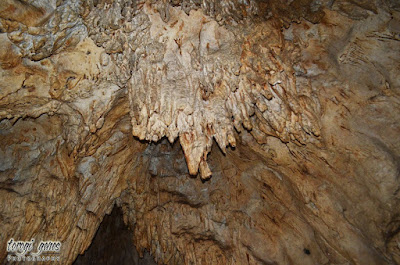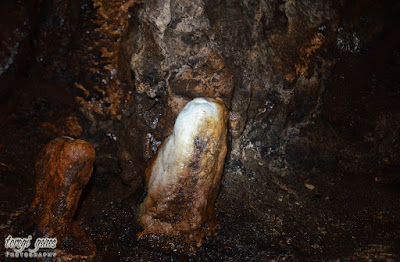LIBTEC CRYSTAL CAVE (a.k.a. QUILLING
CRYSTAL CAVE)
Updated Article is migrated in this link:
LOCATION:
|
Brgy. Libtec,
Dolores, Abra, Philippines.
|
|
HOW TO GET THERE:
|
From
Manila: Partas Bus (fare and schedule here) or Dominion Transit Bus
bound to Bangued. Approx. trip duration: about 9 hours.
From Baguio
City: Take a Partas Bus (Php314.00) or a mini bus (Php250.00) bound to
Bangued. Approx. trip duration: about 6 hours.
Private
vehicles: Directions can be easily asked from the friendly Abra locals.
|
|
Bangued to Libtec, Dolores:
Single
motor: Around Php600.00 (negotiable; round trip, with side trips)
Jeepney +
Tricycle: Take a jeep at Bangued bound to Dolores then drop at Talugtog
crossing. From there, take a tricycle to Libtec.
|
||
Drop-off to cave entrance: During rainy season
when the road is muddy, it takes at least 30 minutes walk. Expect that to be
shorter during summer when the non-cemented part is passable.
|
||
Spelunking duration: About an hour.
|
||
JUMP-OFF POINT:
|
Libtec Road,
Libtec, Dolores
|
|
CONTACT PERSONS:
|
(074)
752-9278; 752-8081 (Mayor’s Office); 0926-403-4485 (Barangay Chairman).
|
|
FEES/RENTALS/FACILITIES:
|
||
Registration Fee:
|
None.
|
|
Guide Fee:
|
Negotiable.
|
|
Shoes, lamp, knee & elbow pads
rental:
|
None.
|
|
Shower facility:
|
None. Not
needed.
|
|
CHARACTERISTICS
|
||
Mineral deposit formations:
|
Highly abundant.
|
|
Underground river:
|
None.
|
|
Bat population:
|
Numerous.
|
|
Chambers:
|
Multi-chambered;
more on caverns.
|
|
Human artefacts:
|
None
discovered yet.
|
|
Cave fill:
|
Bat droppings
and soil partially covering the floor.
|
|
Description
Libtec Crystal
Cave, also known as Quilling Crystal Cave, is located in Dolores, a
municipality in the nature-blessed province of Abra. A haven of bats, this full
of mineral deposit cave is an easy spelunking destination.
The cave is
situated in Barangay Libtec, hence the name Libtec Crystal Cave. The “crystal”
comes from the microcrystals on the surface of the mineral deposits that shines
when light is focused into it. According to the locals, even before the Second
World War when Libtec is not yet populated the presence of the cave is already
known to hunters and trappers from nearby areas such as Tayum, Abra. Decades
after the Japanese regime, treasure hunters had also explored the caves, hoping
that some Japanese treasures were kept and left there. Today, it is a
bat-hunting ground as the cave is heavily populated with kurarapnit (bats). Bat droppings had also been gathered by the
locals to be used as fertilizer. Possibly, other animals use the chambers as a
habitat especially those near the exits.
Libtec Crystal
Cave, like the Sibud-Sibud
Cave in Tineg, is also a multi-chambered cave with a continuous cavern
covering most of its length. It also boasts a multitude of beautifully-formed
mineral deposits in the form of stalagmites, stalactites, straws, drapery, and
flowstones. The length of the cave is not even close to a kilometer but the walls,
floor, and roof are teeming with beautifully-formed and -colored mineral
deposits. There are a lot of stone formation like a bird, banana blossom,
horse, and many more.
Unlike Sagada Caves
and Aran Cave,
spelunking in Libtec Crystal Cave is not as arduous. Crawling, sliding, wading
through icy water and rappelling are not required. It is a generally
easy-take-you-time adventure inside the cave. There are two entry points (could
also be utilized as exit points), however, only one is being utilized since the
other is located halfway along the length of the cave. It is also noticeable
numerous fallen blocks of mineral stones, most probably breakdown happened
during earthquakes. As you enter and marvel at the formations inside, you will
also be serenaded by the flaps and squeaks of bats.
Factors that
hinder the promotion of this beautiful cave include the distance from the NCR
where local tourists usually come from, lack of hourly public transportation,
and the often misunderstood peace stigma of Abra. Like Sibud-Sibud
Cave, Libtec Crystal Cave also has no standard guide fee, guides are not
yet trained like those in the heavily populated cave tourist destinations, and
no spelunking device rentals. Fortunately, the barangay is very keen with the
safety of the tourists. At least one guide is often dispatched to accompany the
tourists.
Other notable
tourist destinations in the municipality are the Libtec Underground River, Simmimbaan
Picnic Groove and a private resort.
Reminders:
|
|
·
|
In hiring transportation,
there is no standard hire rate; approximate trip duration takes as much an
hour.
|
·
|
Wear a
comfortable non-slip, close-toed rubber shoes. Do not use flip-flops
especially during rainy season.
|
·
|
Do not
vandalize the rocks nor take any physical memento from the cave. Whether it
is under the protection of the DENR or not, treat nature with respect.
|
·
|
Do not touch
or step on the surfaces of live dripstones. These are usually colored white
and with continuous water dropping in it.
|
·
|
Be guided by
the Leave No Trace mantra. Take only pictures and memories with you. Leave
the stones and mineral deposit formations behind. As of early 2016, a lot of
the stone formations have been vandalized, some of the tips of the draperys
and stalactites have been cut and taken as memento.
|
·
|
Do not forget
to bring water for rehydration and individual flashlight especially if you are a group.
|
Gallery
The entrance.
This is the only part where you need to stoop-walk.
A closer look
at the entrance.
You would
immediately be welcomed with this.
The roof near
the entrance of the cave.
Unfortunately,
the beauty of the cave have been besmirched many times in the past.
This could have
been more beautiful if the tips have been spared by vandal and thieves.
Dripstones like
these are all over the place.
Each wall has
its own personality.
One of the few
instances where you need to half climb your way.
Flowstones and
shields are also everywhere.
Notice the
myriad of colors the formations has to offer.
A part of one
of the uncounted columns.
A stone
resembling a heart.
A cluster of
uhm… what do they resemble?
The cavernous
space inside the cave.
Everywhere you
look, there would always be something that would catch your attention.
These dripstones
seem like sentries in a hollow place.
Is it a bird? A
gargoyle?
This seems like
a short curtain.
When
stalactites and stalagmites meet, they often form a solid pillar.
A flower?
Banana blossom? Whatever it looks like to you, this could have been perfect
without the vandalized part.
I have always
wondered at the picturesque effect of the different colors of the mineral
deposits.
This is the
most beautiful part, I must say. I call it the “grotto”. If the cave is a
novel, this could have been its climax.
A closer look
at the upper portion of the “grotto”.
I really wanted
to cry when we reached this point. I wanted to cry for a couple of reasons:
one, the desecration of this nature’s art has a bitter tug to my heart; two,
the beauty [and could have been more majestic without the vandalism] of the
place that gives a church-like feeling.
On the other
side of the “grotto” are formations untouched by vandals.
A colorful
column.
These
dripstones are still alive. Decades need to pass before a considerable increase
in size is seen.
The exact
location of the source of the water drops and the mineral content of the drops
are bid factors in shaping these stones.
This shape
could be a lot more different in the future.
You would
almost always forget to close your mouth when you gaze upon things as stunning
as this.
A dome-shaped
part of the roof.
I don’t know
what to call these, but they are sure pretty to look at.
Dang it! Its a horse!
With the rugae,
you would liken it to a scrotal sac.
A majestic
column.
Its white color
and shape makes it unique.
A clenched fist
or a heart maybe?
The
wall-that-is-not-just-a-wall.
Oh please close
your mouth, lol.
By the way, the
previous images were as gargantuan as this. A lot of them are even of bigger
size.
A colorful,
mineral deposit formation-full crevice.
These
screechers would always be present wherever you go inside this cave.
A small
chamber. Unfortunately, I wasn’t able to explore it including the other chambers. It’s for you to discover
the wonders inside when you go there.
NOTE: I initially planned to go to the
Libtec Underground River. However, the place is closed to visitors during rainy
season as it is filled with water. By chance, the Barangay Chairman mentioned
the Libtec Crystal Cave, hence this article. The history of the cave was given
by 2016 Libtec Barangay Chairman. I was saddened at the extent of vandalism
inside the cave. Despite of this, what you will see inside would still capture
your heart.
























































































